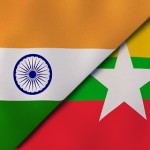The short visit to Myanmar (December 22-23) by India’s Foreign Secretary Harsh Vardhan Shringla had a clearly-etched mandate: to deepen cooperation with an important neighbour. His mission succeeded to a large extent, but challenges remain.
The Indian delegation took a special flight to Naypyitaw and Yangon. It certainly eased logistics for the officials, but was fully utilised as it also carried one million India-made vaccine doses, as a gift to the people of Myanmar.
Regional dimensions
Mr. Shringla followed India’s calibrated middle-path position. Not the west’s reflexive policy of condemnation, threats and sanctions against the military regime, but a position reflective of regional realities. It is no easy task.
Since the military coup on 1 February 2021, the international community has stayed divided on how to address the derailment of Myanmar’s transition to democracy. For a decade, the country’s ‘hybrid democracy’ based on power-sharing between the military and elected representatives ran well enough. But an overwhelming electoral victory of the National League for Democracy (NLD) led by Daw Aung San Suu Kyi in November 2020, unnerved the military leadership. It apprehended that armed with a new mandate, the NLD would move fast to clip the Army’s wings. The Tatmadaw (Myanmar’s military) moved faster, seizing power in violation of the Constitution and putting down the Opposition with an iron hand. The results have been disastrous for democracy, economy and the people’s well-being, especially as the political crisis coincided with COVID-19 ravaging the ‘Golden Land’.
Global dismay was evident in the western sanctions, but others such as Russia saw the opportunity to strengthen ties with the new rulers. China regretted the loss of Daw Suu Kyi as a valuable ally but took urgent steps to stabilise and expand cooperation with the military regime. The Association of Southeast Asian Nations (ASEAN) first showed creativity through its ‘Five-Point Consensus’ formula, but later its unity stood damaged once Myanmar’s top leader Senior General Min Aung Hlaing (picture) refused to cooperate in the formula’s implementation.
In this highly polarised and complex situation, Mr. Shringla has succeeded in holding substantive discussions with the top State Administrative Council (SAC) leadership and political parties including the NLD in Naypyitaw as well as Senior General Min Aung Hlaing and the representatives of civil society in Yangon. India’s position, as conveyed to Myanmar, is similar to and supportive of ASEAN: release of political prisoners; resolution of issues through dialogue; cessation of “all violence”; and full cooperation with ASEAN. In recent years, India has assisted Myanmar through capacity-building programmes for strengthening the transition to democracy. This assistance remains available, but it is not an offer of mediation by India in the military-NLD conflict. This burden will have to be borne by ASEAN.
That India’s position carries confidence is reflected in an unusual interactive meeting Mr. Shringla held with a select group of Myanmar-based foreign Ambassadors.
Bilateral concerns
Myanmar’s military is responding as it can. India’s principal concerns pertaining to border security and stability in its neighbourhood were clearly conveyed, especially the noticeable escalation of activities of anti-India insurgent groups. By handing over five cadres of the Manipur People’s Liberation Army to Indian authorities before the Shringla visit, the military government demonstrated its desire for cooperation. It also renewed the previous pledge that its nation’s territory would not be allowed to be used for any activities inimical to India.
The second issue — the outcome of Myanmar’s instability — is that of refugees. Several thousands of Myanmar people have sought shelter in Mizoram. This will only be reversed by a political settlement in Myanmar, through dialogue. This issue too was taken up seriously, despite the understandable reiteration later of known positions in the regime’s formal take on discussions last week.
Economic cooperation has always been a major agenda item in all bilateral discussions with Myanmar. This visit was no exception, with the usual emphasis on “people-centric socio-economic developmental projects”. Central to this is India’s long-delayed commitment to “expeditious implementation” of mega initiatives such as the Trilateral Highway and Kaladan projects. Unfortunately, no revised deadlines were announced. These projects continue to be the Achilles heel of the relationship.
Protocol departure
Still, India continues to have high equity in Myanmar, which it must now carefully leverage. It is reflected in the special gesture made by Senior General Min Aung Hlaing (who is Chairman of the SAC and Prime Minister) to receive Mr. Shringla and hold detailed discussions in Yangon. This is unusual. The Myanmar establishment is highly protocol-conscious. My innings as Ambassador in Yangon saw three visits by the Indian Foreign Secretary (i.e., two different office-holders), but they were not received by the regime’s highest dignitary. The protocol departure for Mr. Shringla revealed current political realities which should be carefully factored in by those who wrongly argue that China is the only friend Myanmar has.
Also, though the request for the Indian Foreign Secretary’s call on Daw Suu Kyi was not acceded to, as was expected, it should be underlined that New Delhi made the request. There are other ways to pursue the matter as India has done in the past. A quiet approach then resulted in a rare call by this writer on Daw Suu Kyi in January 2003 when she was still under house arrest. Projecting the request this time around may yet produce results.
Back home, the steps to take
Both the Government and the Opposition in Myanmar seem to understand India’s sober approach. India can leverage the gains of this visit and keep up the momentum by inviting Myanmar’s Foreign Minister at an appropriate time as well as other important stakeholders such as leaders of political parties, civil society and think tanks to India for deliberations with their counterparts here. The single goal should be to put Myanmar back on the path of becoming “a stable, democratic and federal union”.
This article was first published in The Hindu.
Rajiv Bhatia is Distinguished Fellow, Gateway House and a former Ambassador to Myanmar.


